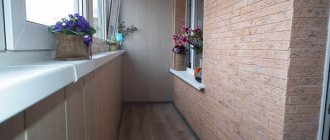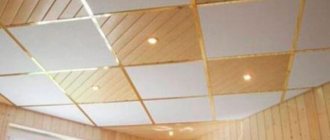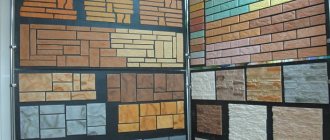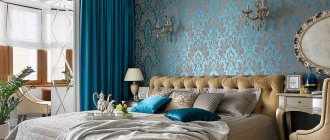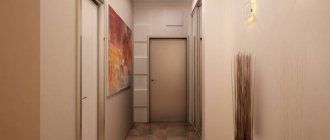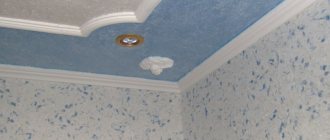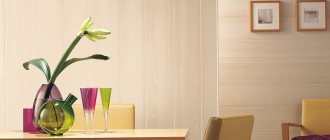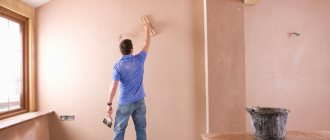Natural and artificial stone
Also an expensive, but extremely effective solution. Using stone (or its polymer imitation), you can recreate walls of marble or granite in noble colors in the bathroom. This gives the interior an extraordinary zest.
Artificial stone is very affordable, so purchasing it will not be associated with large costs. In addition, it helps to recreate various surfaces, such as brickwork.
Types of wall decoration
In addition to tiles, the following materials have these characteristics:
- waterproof paint;
- plastic panels or siding;
- self-adhesive film;
- linoleum;
- oilcloth;
- mosaic;
- moisture-resistant drywall;
- lining made of wood, plastic or MDF;
- porcelain stoneware;
- glass blocks;
- plaster.
Decorative plaster
Porcelain tiles
Plastic panels
Mosaic
Installation of a wall made of hollow glass blocks
Painting the walls in the bathroom
Self-adhesive film
https://youtu.be/Mj5tGz5t5xk
Terrazzo
This is a trendy finishing option, very popular this year. The material is a mixture of glass, pebbles and small fractions of natural stone, therefore, with perfect polishing, an unusually beautiful surface is created. On the other hand, some may find this finishing option too colorful, so we recommend that you familiarize yourself with other options as well.
Oilcloth
Oilcloth will come in handy to make quick repairs. Oilcloth is a fabric impregnated with a waterproof compound. Compared to self-adhesive film, oilcloth has fewer textures, but is not inferior to it in the variety of colors and patterns. Oilcloth also makes it easy to change the interior with your own hands without major expenses, however, this finishing option can be called short-lived. Covering with oilcloth will speed up repairs, and its pattern will refresh the interior of a small room.
Wallpaper and glass wallpaper
Paper wallpaper in the bathroom is a dubious choice, but non-woven wallpaper is a different matter. They are more resistant to moisture and have a porous structure, so they “breathe” and mold does not form under the surface. Another alternative is glass wallpaper. They are difficult to apply, but they create a noble, beautiful coating that will last for many years. Materials can be combined to create a variety of styles.
Linoleum
You can use linoleum to cover the wall in the bathroom. There should be no old tiles or other materials between the wall and the covering, for which you should level the wall, putty the grooves, and then glue the linoleum. You can glue linoleum with your own hands. Linoleum allows you to avoid joints between tiles, where bacteria multiply in a wet environment. Linoleum is a wear-resistant material with a service life of more than 10 years. In addition to regular linoleum, there is special linoleum for walls; it is plastic, durable and moisture-resistant, has different textures or patterns and does not provide joints between materials. In addition, such repairs are easy to do yourself.
PVC film
Polyvinyl chloride is an elastic, waterproof material. Films come in different colors, shades and types of coating, which allows you to bring almost any idea to life. Their advantage is accessibility and ease of installation, and their disadvantage is sensitivity to damage. Scratches, cuts, holes are common defects of PVC films, so you need to be careful with them.
Wall panels
This is an extremely interesting and effective option for decorating a bathroom. Wall panels are ready-made blocks that are mounted on special guides. They significantly speed up interior decoration and help bring to life very ambitious design projects. And, most importantly, wall panels are inexpensive and are available for sale in a wide range.
Chipboard and fibreboard panels
Frankly speaking, this is not the best option, since fiberboards are very sensitive to moisture and readily absorb it. However, you can use panels with increased water resistance. This will help recreate the Victorian style in the bathroom, making it majestic, regal, and incomparable.
MDF panels
This option is more expensive than chipboard, but this is due to its high quality and excellent performance. MDF panels are considered more durable, and they incredibly accurately imitate the surface of natural wood, repeating the pattern of the fibers. Thanks to this, MDF panels have become actively used for bathroom decoration.
Gypsum vinyl panels
We are talking about sheets of drywall, on the surface of which a special layer of vinyl is applied. The result is beautiful wall panels with an attractive pattern. There are many design options available using gypsum vinyl panels, so they can be an excellent choice for interior trim. In addition, this material is resistant to moisture and various damages.
3D panels
An excellent choice for those who appreciate modern interior solutions made in the spirit of minimalism and with clearly defined geometry. Three-dimensional panels help to recreate the relief structure. They take up a lot of space, so they are more suitable for large rooms, but they create an incomparable effect.
Plastic panels
A simple, fast and economical option for finishing a bathroom. These panels are not afraid of moisture, so they do not swell, but it is not recommended to save money and buy products made from cheap plastic, since they can quickly become unusable (increased fragility affects them).
Mosaic
In addition to tiles, you can lay out the walls in the bathroom with mosaics. It is not only practical, but also effective. Mosaics for walls in the bathroom allow you to lay out drawings and decorate even round surfaces or plasterboard niches with mosaics. Mosaic visually increases the height of the wall in the bathroom.
Mosaic can be used as an additional material, laying out the wall above the bathtub, combining it with painted walls or surfaces covered with paint, patterns or MDF panels. Laying a mosaic with your own hands will require certain skills and artistic talents, so it is better to entrust its installation to professionals. GVL or plasterboard in the bathroom, used to create niches or partitions, can also be covered with mosaics.
The types of mosaics are varied, the most common being glass mosaics, which are used from kitchen interiors to swimming pools. Venetian glass is used for this mosaic. Chips or small mosaic details can be either black or multi-colored.
More expensive alternatives
If you have a solid budget or are willing to spend more than average on decorating your bathroom, we recommend taking a look at natural materials. They are more expensive than those listed above, but they have a lot of undeniable advantages, including:
- excellent strength;
- immunity to moisture;
- resistance to sudden temperature changes;
- long service life;
- aesthetic appeal.
A variety of materials are used for this purpose, with natural stone being the leader. This is what is worth considering first.
Marble
It is lighter (relative to granite) and has a beautiful structure with clearly visible veins. In addition, the variety of marble is unusually large, which helps you choose a wide variety of shades. For example, white, yellow, pink or red marble may be suitable for finishing a bathroom. With the right approach, finishing with natural stone turns out to be almost eternal.
Glass panels
They are spectacular and absolutely not afraid of moisture. For production, special tempered glass is used, which is highly resistant to shock and external influences. To create a beautiful effect, you can apply curly engraving to the surface of the glass panels, which will make the finish unique.
Mirror walls
Many people will find this option very attractive. Firstly, glass walls visually expand the space, helping to transform even a small bathroom. Secondly, they fill the room with light, making it more comfortable. This is why mirrors are very popular in the market.
Now you know much more about bathroom finishing options. As you can see, not a single example used tiles, so you can safely move away from established stereotypes and create a designer finish that will please the eye day after day.
GVL or moisture-resistant plasterboard in the bathroom
The use of gypsum fiber board or drywall in the bathroom refers to the rough work stage. At the finishing stage, drywall in the bathroom can be hidden from view. Linoleum, MDF, and other finishing materials can be glued onto the gypsum fiber board or plasterboard of the bathroom wall. Despite the water resistance of GVL, drywall in the bathroom should be protected from prolonged exposure to water.
You can do this yourself: the ends of the drywall and the seams between the sheets can be coated with tile adhesive, which is a moisture-repellent agent. Polyethylene can be laid between the bathroom wall and the GVL sheet, which will protect the GVL from dampness on the inside of the wall. GVL is often used to hide communications, for which gating can be done first, but it is worth remembering that pipes often leak and condensation forms on them, so it is possible to provide an inspection hatch and moisture protection in such a design.
Wall finishing with moisture-resistant plasterboard
GKL tabletop in a niche
